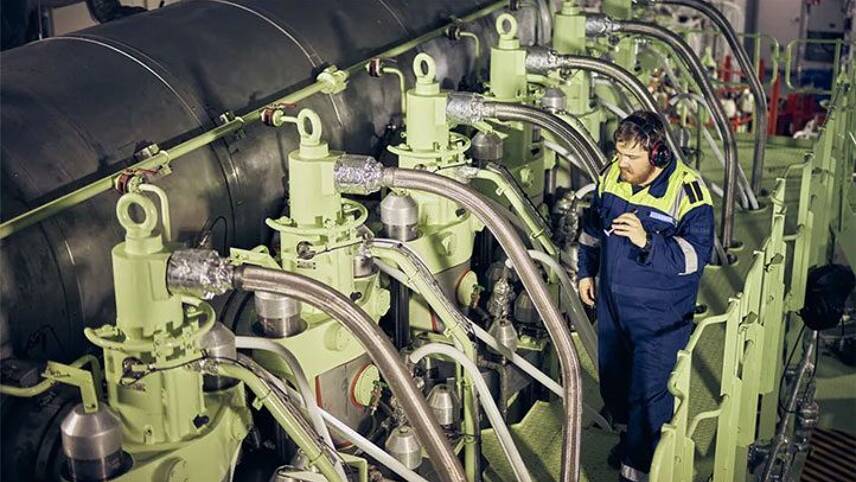Register for free and continue reading
Join our growing army of changemakers and get unlimited access to our premium content

Image: Maersk
After committing to achieving net-zero emissions across its business by 2050, Maersk this year announced its intention to operate a carbon-neutral liner vessel by 2023.
Now, the company has confirmed that it will source the e-methanol used to power the vessel from a facility in Denmark, currently under development by European Energy subsidiary REintegrate. The facility is due to begin production in early 2023, producing around 10,000 tonnes of e-methanol annually.
E-methanol will be produced at the facility from hydrogen, which itself will be produced by using an electrolyser to split water. Then, CO2 from bio-based sources will be added to the hydrogen. All processes will be powered by renewable electricity from a solar farm in Kasso, southern Denmark.
REintegrate has tested the process at a laboratory and is planning to open its first commercial e-methanol plant in 2022. Maersk claims that fuel produced in this manner is carbon neutral.
“This type of partnership could become a blueprint for how to scale green fuel production through collaboration with partners across the industry ecosystem, and it will provide us with valuable experiences as we are progressing on our journey to decarbonise our customers’ supply chains,” Maersk’s chief executive for fleet and strategic brands Henriette Hallberg Thygesen said. “Sourcing the fuels of the future is a significant challenge, and we need to be able to scale production in time.”
The liner vessel which Maersk is touting as the first carbon-neutral boat of its kind will be produced by Hyundai. It will be fitted with dual engine technology, meaning it will be capable of sailing on methanol or traditional fuels.
Maersk is yet to disclose how it will offset residual emissions to deliver carbon neutrality. Maersk last year received communication from the Institutional Investors Group on Climate Change (IIGCC), pressing for better disclosure around its decarbonisation plans and climate risks. 35 other high-emitting companies also received the IIGCC’s call to action.
Virgin Atlantic
In other news relating to the low-carbon transition in transport, Virgin Atlantic has this week signed on as an early customer for a new direct air capture (DAC) facility, planned for Northeast Scotland by carbon capture and storage (CCS) firm Storegga.
The memorandum of understanding (MoU) states that the airline will purchase carbon credits from Storegga, associated with the facility. Storegga claims that the removals achieved at the facility will be “permanent”. It plans to store captured CO2 under the seabed off the Scottish coast.
Storegga is working with technical partner Carbon Engineering to install the facility, which it estimates will capture one million tonnes of CO2e annually after it enters operation in 2026. Virgin Atlantic’s total carbon footprint in 2018 was 5.5 million tonnes of CO2e and it is not yet clear whether it intends to purchase all credits generated by the facility.
“Innovation and sustainability leadership is firmly in our DNA and we’re excited to be the first in the aviation industry to partner with Storegga to progress the development of DAC solutions in the UK,” Virgin Atlantic’s chief commercial officer Juha Jarvinen said.
“Reducing Virgin Atlantic’s carbon footprint is our number one climate action priority and the removal of CO2 directly from the atmosphere has the potential to become a powerful tool in reaching our target of net-zero carbon emissions by 2050.
“We hope that early adoption of this technology and development of a facility here in the UK will demonstrate the commercial potential of DAC and inspire other businesses to be involved.”
Virgin Atlantic’s commitment to net-zero by 2050 was made through its membership to the UK Sustainable Aviation Coalition. The Coalition this year announced new targets for the industry to reduce absolute net emissions by at least 15% by 2030 and at least 40% by 2040, against a 2019 baseline. This approach is the one broadly followed by the UK Government in its Transport Decarbonisation Plan.
Storegga will need to secure planning permission and financial support to build its DAC facility. Its plans involve licencing Carbon Engineering’s technology, which was first used to capture CO2e in 2015. The technology works by sucking in air with a fan before exposing it to a liquid chemical mixture that binds the CO2. This liquid is then turned into solid calcium carbonate pellets which are heated to 900C, whereby they decompose into CO2 and CaO. The CO2 undergoes a final round of treatment before it is stored or sold.
edie recently published a feature exploring the extent to which man-made carbon removal technologies will be used in the global transition to net-zero, given their numerous drawbacks. The feature also explores the pros and cons of nature-based carbon sequestration solutions such as tree planting. You can read that piece here.
Additionally, edie hosts a free-to-download guide on carbon capture, utilisation and storage (CCUS), in association with Carbon Clean. You can access your copy of that guide here.
Sarah George


Direct Air Capture is surely nonsense!? Can anyone point to an authoritative source that explains the rationale? How can it make sense to capture 400ppm CO2 from the atmosphere, rather than 13% by volume at the power-station flue? And we already have cheap and effective tech to capture CO2 from the atmosphere – trees! What am I not understanding here?